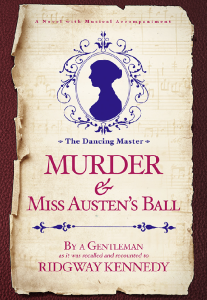
As her 40th birthday approaches, Jane has decided that at her advanced age she no longer needs to worry overly about society’s strictures, and so she will throw herself a ball. She has sent for a dancing master and gets in his place Freddy Worth, an itinerant musician and apprentice dancing master. Nonetheless, after hearing Freddy play, Jane is willing to give him a chance.
Her wealthy neighbor, feckless Aloysius Ellicott, impulsively offers the use of the ballroom at Kellingsford Hall. His father, Lord Horatio Ellicott, Viscount Kellingsford, has gone a bit gaga and only seems concerned about his fashionable clothes. The house and estate are run by older brother Percival who is in the process of enclosing fields formerly used as commons, while calling in debts from a neighbor whose income will suffer from his tenants’ loss of the common land.
Amid this turmoil, Jane moves forward with her ball. There is a hilarious scene of Freddy teaching the dances to red-coated dragoons whom Jane has enlisted to serve as partners, their swords clashing and tangling. Freddy’s naval background comes in handy as he translates dance instructions into parade ground commands.
The ball itself starts off beautifully, but then disaster strikes. Determined to discover what has led to the awful events at her ball, Jane enlists the reluctant aid of her dancing master, who is concerned with protecting her reputation, and they roam far and wide following various leads. Austen fans familiar with what is known of her life will for the most part appreciate this depiction of the author, though some of Jane’s escapades may raise eyebrows.
There are other mysteries in bookstores starring Austen as a detective. What sets this novel apart are the remarkable descriptions of the experience of playing in a small ensemble and of dancing these simple and graceful dances.
In this debut novel, Kennedy brings his considerable expertise playing for and teaching English Country Dance (ECD): country dances of this and other periods, including newly composed ones. (Full disclosure: I have met Kennedy; we both belong to a large traditional dance and music community.)
While it surely helped that I was familiar with the dances named, Kennedy’s evocation of how it feels to dance them is remarkable. I was even more awed by his portrayal of the musical sessions. Not a musician myself, I’m still aware of the subtle signals and changes within an ensemble, the turns at improvisation, the sudden quiet or swelling volume, aware enough to applaud these passages.
Mystery readers will not be disappointed with the fast-moving plot, with its surprises and red herrings. Those who have been to Chawton, Bath, and other places in Austen’s life will recognise the settings that are briefly but effectively described.
Fans of cosy mysteries will enjoy this light-hearted romp through Jane’s world. For me, it brightened these bleak midwinter days.
What books have you turned to for a bit of cheer during this month of shortening days?
Disclosure of Material Connection: I received a copy of this book free from the publisher. I was not required to write a positive review. The opinions I have expressed are my own.
